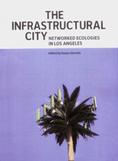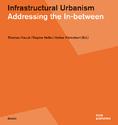large scale plans & projects safety & security open spaces history job populations rigenerazione urbana downtowns transport & logistics strategic planning urban design inu commerce urban africa scenarios industrial sites urbanization ecology urban theory public spaces social capital European policies collaborative urban design simulation waterfronts & harbors
The Infrastructural City: Networked Ecologies in Los Angeles
edited by Kazys Varnelis, maps by Leah Meisterlin
Once the greatest American example of a modern city served by infrastructure, Los Angeles is now in perpetual crisis. Infrastructure has ceased to support its urban plans, subordinating architecture to its own purposes. This out-of-control but networked world is increasingly organized by flows of objects and information. Static structures avoid being superfluous by joining this system as temporary containers for people, objects, and capital. This provocative collection of photography, essays, and maps looks at infrastructure as a way of mapping our place in the city and affecting change through architecture.
"This book can only offer a partial insight into Los Angeles. In this immensely complex landscape, we cannot hope for a total approach the way that Banham did. Insted we set out to paint a picture of a particularly crucial aspect of the city, its dominance by an out-of-control infrastructure. To accomplish this, we can still turn to Banham's idea of ecologies as well as to the method of geographer Anton Wagner in his 1935 analysis of Los Angeles, a work profundly influential on Banham. (...) If we begin with Wagner's idea of looking at the city as landscape and Banham's notion of ecologies, we need to be more critical. Ecologies were still innocent in the 1960s. By now, today they are much more complicated. (...) We treat it in terms of networked ecologies, a series of codependent systems of environmental mitigation, land-use organization, communication and service delivery".
From: "Introduction. Networked ecologies" by Kazys Varnelis
A project by:
The Network Architecture Lab Graduate School of Architecture, Planning and Preservation, Columbia University and The Los Angeles Forum for Architecture & Urban Design
CONTENTS
Introduction
Networked ecologies
Kazys Varnelis
1. Landscape
Owens Lake. Reconstructing the Void
Barry Lehrman
Los Angeles River Watershed. Flood control Freakology
David Fletcher
Oil. Crude City
Frank Ruchala
Gravel. Margins in our midst
Matt Coolidge
Center for Land Use Interpretation
2. Fabric
Traffic. Blocking all lanes
Sean Dockray, Fiona Whitton, Steve Rowell
Telecommunications. Invisible city
Kazys Varnelis
Landscape. Tree Huggers
Warren Techentin
Mobile phones. Cell structure
Ted Kane & Rick Miller
3. Objects
Property. Counting (on) change
Roger Sherman
Distribution. Consumers gone wild
Deborah Richmond
Props Story of the eye
Robert Sumrell
Picturing Los Angeles: the Linear City
The River. The Los Angeles River
The Street. Wilshire Boulevard
The Trench. The Alameda Corridor
ABOUT THE AUTHOR:
The Network Architecture Lab (NETLAB) is a research unit in Columbia University’s Graduate School of Architecture, Planning, and Preservation. The Netlab investigates how computation, communications, and changing social networks im,pact architecture and the city.
The Los Angeles Forum for Architecture and Urban Design is a non-profit organization dedicated to supporting innovative art, architecture, design, and urbanism. The Forum generates events, initiates publications, and instigates discussion to engage both design professionals and the broader community in Los Angeles and beyond.
Kazys Varnelis (http://kazys.varnelis.net) is the Director of the Network Architecture Lab at the Columbia University, Graduate School of Architecture, Planning, and Preservation.
Based in New York, Varnelis has been a visiting lecturer at the University of Southern California, University of Pennsylvania, and the Massachusetts Institute of Technology. He has worked with the Center for Land Use Interpretation and is a co-founder of AUDC, which published Blue Monday: Absurd Realities and Natural Philosophies, 2007, and editor of Networked Publics and The Philip Johnson Tapes: Interviews by Robert A.M. Stern, 2008. He was president of the Los Angeles Forum for Architecture and Urban Design in 2004 and 2005.
Related articles:
Online resources and links




Planum
The Journal of Urbanism
ISSN 1723-0993
owned by
Istituto Nazionale di Urbanistica
published by
Planum Association
ISSN 1723-0993 | Registered at Court of Rome 4/12/2001, num. 514/2001
Web site realized by ChannelWeb & Planum Association | Powered by BEdita 3


